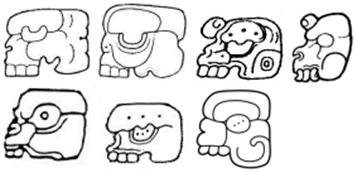


K&H.p83.#3 K&H.p73 BMM9.p15.r5.c3
DPL HS 4 G1
JOL JOL JOL


![]()
K&L.p24.#2 TOK.p22.r2.c1 MC.p163.r6.c7
JOL JOL JOL
· JOL / “head” and the skull variant of CHAM / “die” both share the fact that they look like a skull.
· Note: not “head”, which is BAAH, but specifically “skull” Really? I’m still unsure – the glyph looks like a skull (is in fact, of course, the drawing of a skull), but there must be some contexts where it’s used to mean “head”. The ruler’s name Nu’un Jol Chaak surely means “Stammering Head Chaak” rather than “Stammering Skull Chaak”?
· Dorota Bojkowska: caution K&L.p24.#2.7 is probably XIM and not JOL – what are the diagnostics?
· Features:
o Nose depression.
o No ear (present in CHAM).
o No % element (helps to distinguish it from CHAM, which has optional %).
o No bottom jaw (helps to distinguish it from CHAM, which has bone-jaw).
o 2-4 teeth from top jaw, hanging downwards from an upper jaw, which is not a bone-jaw (helps to distinguish it from CHAM, which has teeth resting on the top of a lower jaw, which is a bone-jaw).
o Optional oval with 3 dots or tiny dots (shared with CHAM, though more common in JOL) – the 3 dots or tiny dots can also be inside the eye or inside the eye protector.
o Dorota Bojkowska: occasionally, there will be eyeball at the forehead – in the iconography, the God of Death has such an eyeball.
o “Kidney eye” (tips pointing upwards) + “cover” with 3 tiny dots inside.
o No lower jaw – bone jaw, which CHAM has.
o 3 tiny dots in a row, optionally in an oval or kidney-shaped protector, which CHAM (generally) doesn’t have.
· Do not confuse this with the visually similar CHAM:
o JOL has no lower jaw – the upper teeth always hang from the upper jaw with nothing underneath them, whereas in CHAM, there is a lower jaw – either just the bottom part of the line surrounding the head, or an actual bone-jaw.